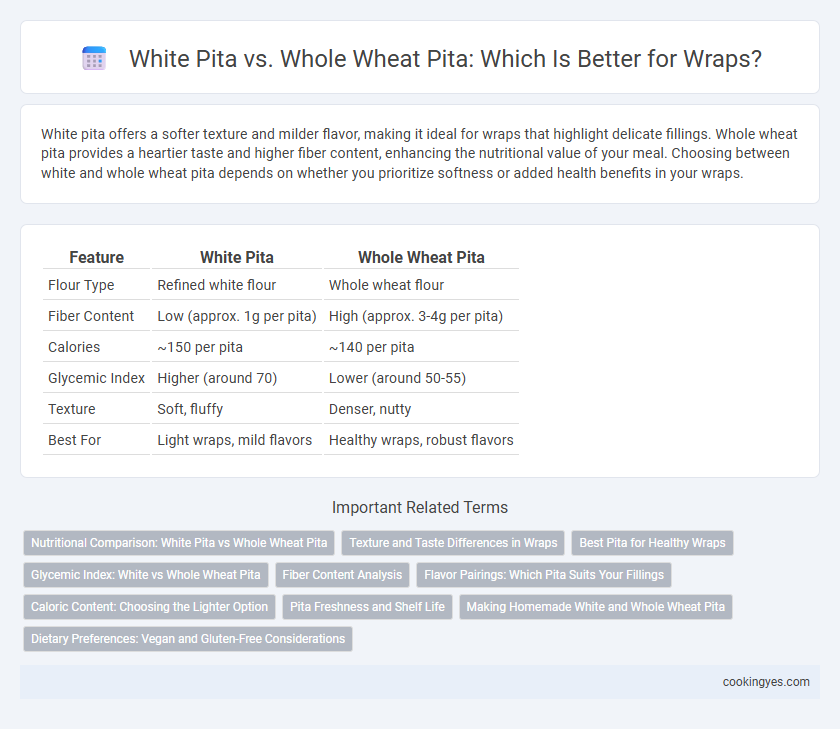White pita offers a softer texture and milder flavor, making it ideal for wraps that highlight delicate fillings. Whole wheat pita provides a heartier taste and higher fiber content, enhancing the nutritional value of your meal. Choosing between white and whole wheat pita depends on whether you prioritize softness or added health benefits in your wraps.
Table of Comparison
| Feature | White Pita | Whole Wheat Pita |
|---|---|---|
| Flour Type | Refined white flour | Whole wheat flour |
| Fiber Content | Low (approx. 1g per pita) | High (approx. 3-4g per pita) |
| Calories | ~150 per pita | ~140 per pita |
| Glycemic Index | Higher (around 70) | Lower (around 50-55) |
| Texture | Soft, fluffy | Denser, nutty |
| Best For | Light wraps, mild flavors | Healthy wraps, robust flavors |
Nutritional Comparison: White Pita vs Whole Wheat Pita
Whole wheat pita contains higher fiber content, essential minerals like magnesium and zinc, and more protein compared to white pita, promoting better digestion and sustained energy levels. White pita typically has a softer texture and lower fiber but provides quick-release carbohydrates suitable for immediate energy needs. Choosing whole wheat pita supports improved heart health and blood sugar regulation due to its lower glycemic index and nutrient density.
Texture and Taste Differences in Wraps
White pita offers a softer, fluffier texture with a mild, slightly sweet flavor that enhances the overall taste of wraps without overpowering fillings. Whole wheat pita provides a denser, chewier texture and a nuttier, earthier taste, adding depth and a heartier bite to wraps. Choosing between white and whole wheat pita depends on personal preference for texture and taste balance in the wrap experience.
Best Pita for Healthy Wraps
Whole wheat pita is the best option for healthy wraps due to its higher fiber content, which supports digestion and helps maintain steady blood sugar levels. Unlike white pita, whole wheat pita retains essential vitamins and minerals such as B vitamins, iron, and magnesium. Choosing whole wheat pita enhances the nutritional value of wraps while providing a denser texture and richer flavor.
Glycemic Index: White vs Whole Wheat Pita
Whole wheat pita typically has a lower glycemic index (GI) than white pita, which means it causes a slower, more gradual rise in blood sugar levels. The higher fiber content in whole wheat pita contributes to improved blood glucose control and increased satiety. Choosing whole wheat pita over white pita can be beneficial for managing blood sugar and supporting sustained energy levels in wraps.
Fiber Content Analysis
Whole wheat pita contains significantly higher dietary fiber compared to white pita, typically offering about 3 to 4 grams of fiber per serving versus 1 gram in white pita. The increased fiber in whole wheat pita promotes better digestive health and helps in maintaining stable blood sugar levels. Choosing whole wheat pita for wraps enhances nutritional value and supports longer satiety due to its rich fiber content.
Flavor Pairings: Which Pita Suits Your Fillings
White pita offers a soft, slightly sweet flavor that pairs well with mild fillings like grilled chicken, hummus, and fresh vegetables, enhancing subtle tastes without overwhelming them. Whole wheat pita provides a nuttier, earthier profile ideal for robust fillings such as spiced lamb, roasted vegetables, and sharp cheeses, complementing stronger, bolder flavors. Choosing between white and whole wheat pita depends on whether the goal is to highlight delicate ingredients or to balance hearty, intense fillings.
Caloric Content: Choosing the Lighter Option
White pita generally contains fewer calories compared to whole wheat pita, making it a lighter option for wraps. On average, a white pita has around 140-160 calories per serving, whereas whole wheat pita ranges from 170-190 calories. Selecting white pita supports lower caloric intake while still providing a soft, pliable base for nutritious fillings.
Pita Freshness and Shelf Life
White pita typically offers a softer texture and longer shelf life due to refined flour's lower oil content, maintaining freshness for up to 7 days when stored properly. Whole wheat pita, rich in fiber and nutrients from whole grains, tends to have a shorter shelf life of about 4-5 days because of its higher natural oil content, which can lead to faster staling. Proper storage in airtight containers and refrigeration can extend the freshness of both types, but white pita generally remains pliable longer, making it ideal for wraps that require flexibility.
Making Homemade White and Whole Wheat Pita
Homemade white pita offers a soft, airy texture perfect for wraps, achieved by using refined flour and yeast for a light rise and tender crumb. Whole wheat pita provides a denser, nuttier flavor with increased fiber content, beneficial for digestive health, by incorporating whole grain flour and slightly longer resting times. Both types of pita require careful dough hydration and baking at high temperatures to create characteristic pockets ideal for stuffing with fresh ingredients.
Dietary Preferences: Vegan and Gluten-Free Considerations
White pita is typically made from refined wheat flour, offering a softer texture but lacking fiber and nutrients compared to whole wheat pita. Whole wheat pita provides higher dietary fiber and essential nutrients, making it a better option for those seeking a more nutritious vegan wrap. Both options contain gluten, so neither white nor whole wheat pita is suitable for gluten-free diets without a specialized gluten-free version.
White pita vs Whole wheat pita for wraps Infographic

 cookingyes.com
cookingyes.com